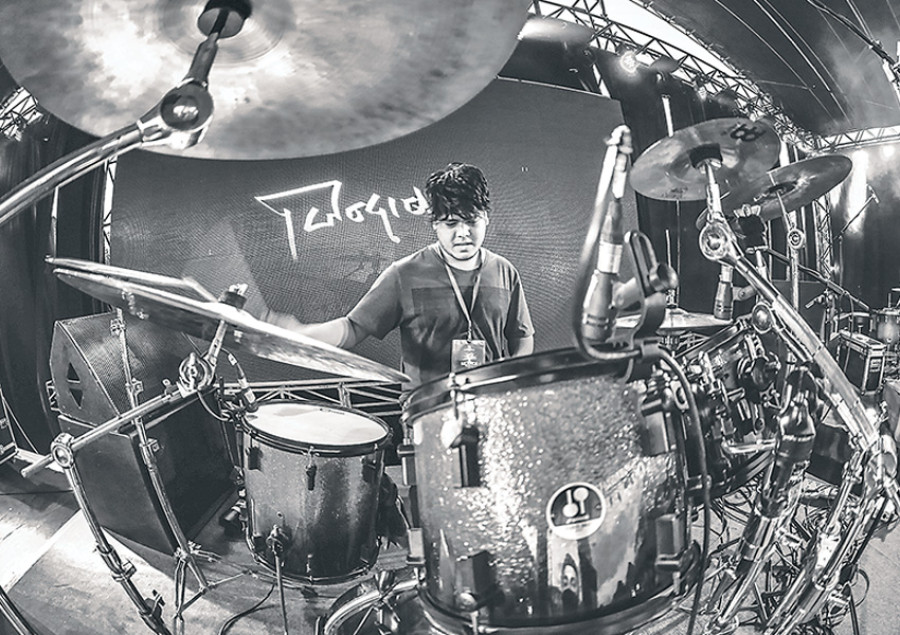Miscellaneous
Metronome man for the Mad Jazz Quartet
Kiran Shahi is the drummer’s drummer; for him, it’s all about sound fundamentals
Amir Maharjan
Kiran Shahi’s personality changes with the group he’s backing. In his role as the designated metronome man for Mad Jazz Quartet, he looks stiff: his hands move in arcs very close to his chest, unless when he’s splashing the cymbals or tapping the high hat, when he’ll close his eyes and sort of slide his self into the groove. If you were to catch him at practice with Jindabaad, you’d have found him very Lars Ulrich-like—like a loosey-gooseyy octopus going crazy with sticks who loves to put the pedal to the metal on the bass drum.
His physical form is not just for show. It actually mimics the rhythm he is keeping in his head. And his body’s movements are but extensions of the beat. Shahi is as adept at juggling the poly-rhythms needed for the Mad Jazz Quartet, as he is at laying down the staccato, John-Bonham-inspired beat that progressive rock outfits like Jindabaad want. He’s known in the music circle for being able to easily move between genres.
Shahi is the drummer’s drummer; because for Shahi, it’s all about sound fundamentals.
Shahi started listening to progressive rock and metal bands like Dream Theater at a very early age. The experimental band still has a lot of influence on his drumming style, which can be seen in Jindabaad’s songs, such as in Shades of You. Alumni of the Kathmandu Jazz Conservatory (KJC), Shahi learned his basics from jazz drummer Antonio Alvarez. In KJC, he got the opportunity to meet with different musicians, and he got exposed to other genres of music that interested him. After completing the course in KJC, he taught there for a while. He then joined the British School, where he is currently working as a music assistant. The international platform that the British school provides has given him the opportunity to learn more about music.
“For me, you don’t stop growing at a specific age. You stop growing when you stop learning,” says Shahi, as he talks about many online music classes he has taken, such as in Latin drumming, music theory, ear tests, and so on. He also spends most of his time searching for free videos and books—if courses aren’t available—on music. Compiling all of this knowledge, he has come to master some of the most difficult genres, like jazz and progressive rock, both of which demand lots of improvising and experimenting.
Shahi does not have a specific practice routine. Instead, he is always either clapping his hands or tapping his feet to maintain a tempo while he plays with the notes in his brain. He even practices his double-bass exercises when he is out of the studio, when waiting for the traffic light to change, for example.
It is pretty amusing to see a drummer of his calibre practicing his basic syncopation exercises. The exercises help involve the movement of the legs and the arms under notes with different time signature and note divisions.
Shahi does not want to confine himself to just playing and jamming with his peers. He wants to pass on the fundamentals he has learned to the next generation of Nepali drummers. Along with some drummers, Shahi in the past started a group called Drummer’s Circle, which organised events such as workshops and concerts to encourage younger generations to pick up a stick and start belting beats.
He recently expanded the group and turned it into a musical institute, where interested students can learn other instruments like the guitar, bass or piano, even voice. That’s because Shahi believes learning the fundamentals of drumming isn’t enough for one to become a drummer. He encourages students to learn more about music theory, about topics that are not interlinked with drumming—such as music scales, and the traditional and more recent chord progressions in blues and rock. Apart from the drums, he plays a bit of piano and he thinks that this has helped deepen his knowledge of genres like jazz. “A drummer’s work isn’t just to maintain his tempo and give a beat to a song. He is also responsible for leading the other band members, and to do that, a good drummer should know the fundamentals of other instruments too,” he says.
Unlike in many other institutes, the beginners in Shahi’s institute aren’t allowed to touch the drums for the first few classes—they don’t even need a stick to be in class. All they require is a notebook, and all they have to do is clap or click, and say “chit” at the designated notes. The beginners are taught The Language of Drumming. Popularised by a German drummer, Benny Greb, who travelled to India and merged his learning of traditional music in his DVD-led course, The Language of Drumming teaches its audience the fundamentals, or as he calls them, the alphabets to the drumming language. In class, Shahi starts a metronome with a speed of 80 bpm, and asks his students to click or clap the “alphabets” of the drum language along with the sound of the note or the “chit” sound that Shahi makes.
Shahi then slowly moves to different styles of gripping a drum stick, the types of strokes and the PASIC rudiments—the drumming basics such as the paradiddle, drag, and the single stroke, which the Percussion Arts Society (PAS) have listed as the building blocks of drumming. After that, he moves on to syncopation, and finally, the students can start using the drums. But in between, Shahi also teaches about notations, time signatures and other theories. Even if you’re in an advanced level, the class doesn’t start without a bit of “chit” and some clapping. Later on, he introduce his students to ear testing, other genres of playing, improvising, and sometimes even an introduction to a different percussive instrument. “The alphabets of drumming, along with the PASIC rudiments, are the essence of drumming. However, these are really hard to master, and requires years of practice,” Shahi says.
Shahi has been an inspirational figure for quite a few upcoming drummers. His expertise in more than one genre has also won him fans among professionals. He believes that imparting the right fundamentals to his students will help them build the base that the next generation of drummers can build on.




 13.12°C Kathmandu
13.12°C Kathmandu










